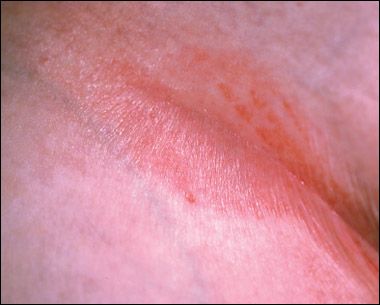How do you explain this chronic, malodorous rash?
An obese 60-year-old woman presents with a chronic malodorous, itchy rash in her groin.


Case 2:
An obese 60-year-old woman presents with a chronic malodorous, itchy rash in her groin.
Case 2: Intertrigo

Obesity predisposed this patient to intertrigo, D. Heat, moisture, maceration, friction, and lack of air circulation can induce or aggravate this inflammatory condition of the skin folds. Secondary infection often occurs; it usually is candidal, but it can be bacterial, viral, or other fungal infection.
The axillae, perineum, inframammary creases, and abdominal folds are the most common sites of involvement. The apposed skin surfaces rub against each other, causing erosions that become inflamed. Sweat, feces, urine, and vaginal discharge may aggravate intertrigo.
Useful laboratory studies include potassium hydroxide examination, Gram staining, and culture to rule out primary or secondary infection and to guide therapy. Wood lamp examination can exclude erythrasma.
Poll Results
Online Poll
Powered By
WebsiteGear
: Requires Javascript Enabled On Your Browser.
The key to treatment is to eliminate friction, heat, and maceration by keeping the skin folds cool and dry. This can be accomplished by using air-conditioning and absorbent powders and by exposing skin folds to the air. Compresses with aluminum acetate (Burow) solution 1:40, dilute vinegar, or wet tea bags often are effective, especially if followed by fanning or cool blow-drying. Skin surfaces in deep folds can be kept separated with cotton or linen cloth; however, advise the patient to avoid tight, occlusive, or chafing clothing or dressings. Moisture-wicking undergarments are helpful.
Antimycotic agents (miconazole, clotrimazole) may be helpful, especially if they are used with a mild- to mid-potency (class III to VI) corticosteroid for a short duration. Avoid stronger topical corticosteroids because the occlusive effect of skin folds can accelerate the development of skin atrophy and striae.